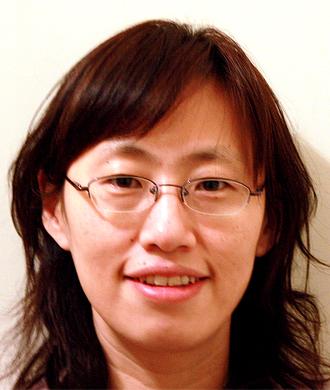Shuli
Xia
,
PhD
Breadcrumb
Home Patient Care Faculty & Leadership Shuli Xia, PhD
707 N. Broadway
Baltimore, MD 21205
United States
About
Shuli Xia is a research scientist at the Kennedy Krieger Institute. She is also an associate professor in the Department of Neurology at The Johns Hopkins University School of Medicine.
Education
Dr. Xia received her doctoral degree in biology from Johannes-Gutenberg University in Mainz, Germany. She had her post-doctoral training at Washington University School of Medicine in St. Louis, MO and Yale University School of Medicine in New Haven, CT before she came to the Kennedy Krieger Institute in 2002. She became a faculty member at the Kennedy Krieger Institute in 2006.
Research Interests
Glioblastoma (GBM, grade IV glioma) is the most common and lethal malignant brain tumor in adults with a dismal prognosis. My research focuses on (1) understanding how malignant brain tumor cells interact with their microenvironment, (2) developing novel anti-GBM therapies and test them in pre-clinical models, (3) identifying genetic and epigenetic mechanisms of brain tumor migration and invasion.
(A).Targeting the immunosuppressive microenvironment of brain tumors
Elevated extracellular matrix (ECM) components drive GBM progression by promoting tumor cell proliferation, migration, and immune evasion of tumor cells. Identifying novel therapeutic strategies to disrupt oncogenic ECM would potentially be highly effective by simultaneously targeting tumor cells and the tumor microenvironment. Uridine diphosphate-glucose 6-dehydrogenase (UGDH) is the rate-limiting enzyme that catalyzes the biosynthesis of glycosaminoglycans, the major ECM component in the brain. Our study reveals that UGDH is a promising target for GBM.
Tumor-associated microglia/macrophages (TAMs) are the main innate immune effector cells in GBM and constitute 30-40% of a tumor mass. TAMs predominantly exert immunosuppressive and pro-tumoral functions, but they are capable of directly targeting tumor cells if properly activated. Strategies that promote the anti-tumor function of TAMs are greatly desired to reverse the immunosuppressive tumor microenvironment in GBM. Our laboratory found that the ECM contributes to the anti-GBM effect induced by targeting CD47, a “don’t eat me” signal overexpressed in GBM cells.
(B). Targeting cancer stem cells in GBM
GBM stem cells (GSCs) play a fundamental role in therapeutic resistance and tumor recurrence. My laboratory is interested in targeting GSCs by driving their differentiation or inducing their apoptosis. We found retinoid acid, histone deacetylase inhibitors, and the transcription factor Krüppel-like family of transcription factor 9 (KLF9) are able to drive GSC differentiation, inhibit self-renewal of GSCs, and inhibit GBM growth in pre-clinical models.
(C). Genetic and epigenetic mechanisms of brain tumor migration
Our laboratory demonstrated that the transcription factor kruppel-like factor 4 (KLF4) functions as a reader for methylated DNA to activate gene expression, thereby promoting GBM cell migration and altering mitochondrial functions. We also established an innovative dual-fluorescence approach to study brain tumor migration and invasion in vivo. We found EphB2 dictates glioblastoma proliferation/migration dichotomy.
Related Links
Elsevier Fingerprint Engine Profile for Shuli Xia
Google Scholar Profile
Selected publications
Ma D, Liu S, Lal B, Wei S, Wang S, Zhan D, Zhang H, Lee R, Gao P, Lopez-Bertoni H, Ying M, Li J, Laterra J, Wilson M and Xia S. Extracellular matrix protein tenascin C increases phagocytosis mediated by CD47 loss of function in glioblastoma. Cancer Research, 2019, 79(10), 2697-2708. https://www.ncbi.nlm.nih.gov/pubmed/30898840
Oyinlade O, Wei S, Lal B, Laterra J, Zhu H, Goodwin C, Wang S, Ma D, Wan J, Xia S. Targeting UDP-α-D-glucose 6-dehydrogenase inhibits glioblastoma growth and migration. Oncogene, 2018, 37(20):2615-2629. https://pubmed.ncbi.nlm.nih.gov/29479058/
Wei S, Wang J, Oyinlade O, Ma D, Wang S, Kratz L, Lal B, Xu Q, Liu S, Shah S, Zhang H, Li Y, Quiñones-Hinojosa A, Zhu H, Huang Z, Cheng L, Qian J, Xia S. Heterozygous IDH1R132H/WT created by “single base editing” inhibits human astroglial cell growth by downregulating YAP. Oncogene, 2018, 37, 5160-5174. https://www.nature.com/articles/s41388-018-0334-9
Wan J, Su Y, Song Q, Tung B, Oyinlade O, Liu S, Ying M, Ming GL, Song H, Qian J, Zhu H and Xia S. Methylated cis-regulatory elements mediate KLF4-dependent gene transactivation and cell migration. eLife. 2017; 6, e20068. https://www.ncbi.nlm.nih.gov/pmc/articles/PMC5466421/
Xia S, Lal B, Tung B, Wang S, Goodwin CR and Laterra J. Tumor microenvironment tenascin-C promotes glioblastoma invasion and negatively regulates tumor proliferation. Neuro Oncol. 2016; 18(4):507-17.https://pubmed.ncbi.nlm.nih.gov/26320116/
